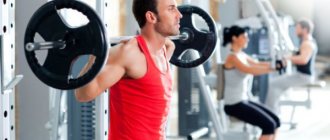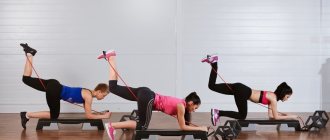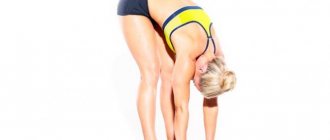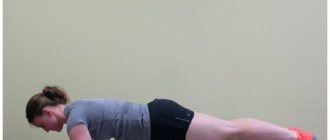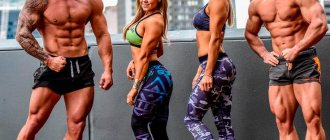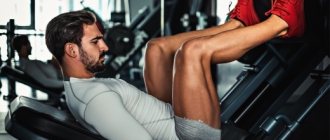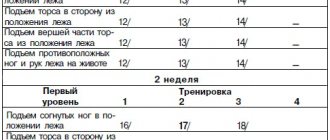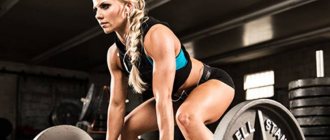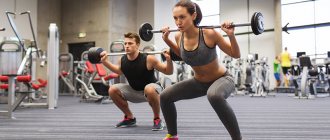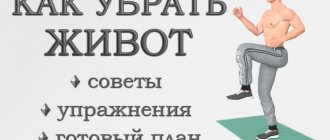Hello, friends. What is circuit training for boxers? By what methods is it carried out? What cycles are present in it, and how long do they last?
The essence of such training is that the necessary volumes of exercise are selected to develop different muscle groups.
Exercises are implemented in a strict algorithm and in one cycle (circle). When it is completed, the boxer pauses for a maximum of 2 minutes and begins the next cycle. On average 5 laps are performed
Exercises should be selected taking into account the training objective and the degree of physical development of the students.
What does physical training develop?
Video: Physical training of a drummer
To do this, it is important to regularly visit the gym, since strength exercises develop stamina, endurance, striking power and performance in a fighter. Good general physical shape is an undoubted advantage over an opponent in terms of strength.
During training, it does not matter which muscle groups you train, the whole body must be trained in boxing.
The main task
As a rule, in general physical training there is no sparring; here the main task is to develop your body and spirit. Despite this, basic physical activity is aerobic in nature.
Such physical activities include:
- run;
- abdominal exercises;
- jumping rope;
- training hand endurance;
- work on apparatus, exercises on uneven bars and horizontal bar.
There are several basic exercises that significantly improve a fighter’s overall physical fitness.
General physical exercises for the development of a boxer
The advantages of such activities
Circuit training in boxing has the following advantages:
- Solid efficiency.
- All muscles are toned.
- Development of endurance.
- The cardiovascular system is strengthened.
- The respiratory organs are strengthened.
- This is the best option for beginners.
- Classes do not take much time. They do not need special conditions and a wide range of projectiles.
Great importance is given to the algorithm for implementing exercises. It is formed according to the scheme of competently changing the load, now on one or another muscle.
The trainer also determines the optimal intensity. The strength of the trainees is distributed throughout the entire training process. Modest loads start first. Gradually they develop.
Each exercise is separated from the next by a pause of 15 seconds.
The optimal frequency for such training is three times a week (minimum).
Run
The first and main aerobic exercise for a fighter is running. Although at first glance it may seem that running is the simplest thing that can be done in training, you just need to put on a tracksuit and sneakers, but in fact, this is far from the case.
Running techniques in boxing differ from generally accepted concepts of running. For a boxer, running should bring the greatest possible benefit.
So, during training it is customary to use several main types of running:
- running up the stairs,
- interval running,
- cross,
- cross with weights.
Cross
Cross-country is designed to maintain the general physical fitness of a boxer, and cross-country with weights is designed to develop endurance.
In addition, weights are also used, as a rule, they are ordinary dumbbells. When a boxer trains with dumbbells while running, his forearm muscles are trained and due to this, his punching power increases.
For a novice boxer, in this case, it is important not to rush to extremes, you need to start with short distances and gradually increase the load.
Interval running
The next important control is the interval method, better known as burst running. It allows you to get used to the interrupted and uneven pace and speed.
This method is very useful for boxers, since in the ring you often have to change your style of behavior.
Running up stairs or jogging
The essence of ragged running is that the fighter runs evenly, at low speed, and every 20-25 seconds the pace of running sharply accelerates by 10 seconds.
This method trains endurance and regulates breathing while running up the stairs. Running on sand or rough terrain can give similar results.
EXERCISES TO DEVELOP ENDURANCE
General endurance develops as a result of constant, systematic exercise. These include various sports-auxiliary exercises performed at a rapidly changing pace and for a relatively long time. Their goal is to expand the athlete’s functional capabilities.
Run
Medium and long distance running is the best exercise for developing overall endurance, strengthening the cardiovascular and respiratory systems. Nothing else can be a better objective indicator of overall endurance than the time shown in running a particular distance.
Long running is carried out during training on the road, i.e. on the day of general physical training. Running like this usually ends a set of exercises on the road.
Traveling on skis
Skiing is rightfully considered the most healthy winter sports exercise. A ski trip in the fresh air strengthens the athlete’s body as a whole and makes him feel cheerful. Skiing has not only health benefits for a boxer, but also training, contributing to his overall endurance.
Swimming
The great health and practical value of swimming is undoubtedly. It harmoniously develops the muscles of the body, promotes the development of endurance, and strengthens the cardiovascular and respiratory systems.
Sport games
Sports games develop a whole range of qualities, including the quality of endurance.
Walking
Walking, carried out as sports training on the ground, is the main exercise in the system of general physical training of a boxer at all stages of his training. Long walks are the best way to achieve and maintain general physical fitness.
Rowing
Long-distance rowing is a good exercise for developing strength endurance.
Exercises with a jump rope
These exercises, performed at a fast pace and for a long time (up to 10 minutes), are excellent for developing the overall endurance of a boxer.
Jump rope
It is important to note that perhaps the best and most versatile training device for a boxer is a jump rope. First of all, because it is convenient to carry it with you always and everywhere.
What does it develop?
In addition, the jump rope perfectly develops coordination and muscles.
Technique
The jumping technique is also quite varied and largely depends on the physical fitness and general skills of the boxer.
Training with a jump rope can be:
- simple jumps with the rope rotating forward,
- jumping with a double rotation of the rope,
- jumping while rotating the rope backwards
- criss-cross.
It is important to gradually increase the frequency and complexity of jumps.
The minimum number of regular jumps for a professional is 240 times/min. The biggest advantage for a fighter using jump rope, as opposed to training on the uneven bars, is that with it you can jump whenever and wherever you want.
EXERCISES TO DEVELOP SPEED
The development of general speed is carried out in general physical training classes.
Run
Running is the main exercise that develops overall speed. Short runs, 40-60 m each, while training a boxer on the road are excellent for developing speed.
Sport games
Various sports games develop the qualities necessary for a boxer: mobility, orientation, agility, resourcefulness, and speed of action.
Particularly useful are games of handball, basketball, football, volleyball and hockey in winter.
Using sports games in training, boxers can play in two teams or use individual technical and tactical elements of the game: dribbling and passing the ball, tactical combinations, etc. A special place in sports games for a boxer is occupied by table tennis - a game that requires quick reaction.
Exercises with a jump rope
Performed at a fast pace (up to 130 revolutions of the rope per minute), these exercises serve as an effective means of developing speed of movement.
Push-up
Modern requirements for boxers are quite stringent and require serious physical training from the fighter. Here, push-ups play a significant role. So, you can do push-ups both from the floor and using a horizontal bar or parallel bars.
What does it develop?
When doing push-ups, a boxer primarily develops the chest, triceps, and shoulder muscles.
Push-ups with fists
Push-ups using your fists also train your muscles perfectly. They are able to make a fighter’s fists straight and the knuckles on his fists harder.
Palm clap push-ups
Push-ups with clapping hands are considered more difficult. Gradually, you can increase the complexity and number of approaches when doing push-ups, for example, clap your palms on your chest and above your head.
Push-ups with clapping hands behind your back
But the most difficult push-up method is considered to be a push-up with clapping your hands behind your back. Such push-ups perfectly develop a fighter’s body, and also increase arm endurance and explosive power.
Strength program
There are 9 main exercises here. They are performed in three cycles. The cycles are repeated three times. Required equipment: a pair of dumbbells or weights. Their mass is selected based on your physical potential.
Cycle 1 includes the following exercises:
- Starting position – plank. Dumbbells in hands. Hands are raised one by one. The entire body turns upward. The hips do not change position. Number of repetitions – 15.
- Position – standing on the left leg. The right one bends at the knee and rises. The position of the hands is parallel to the floor. They are bent at the elbows - 90 degrees. The lower arm rotates. The number of repetitions for one leg is 15.
- Position: feet stand shoulder width apart. Dumbbells in both hands. Squats follow. The back is straight. Hips are parallel to the floor. As you rise from a squat, press the weights upward. Number of repetitions – 15.
In the second loop you need to do the following:
While in a lying position on your back, spread your arms holding dumbbells. Legs bend 90 degrees. The lower back is pressed to the floor. The arms are raised and brought together, spread to the sides. Forearms are raised above the floor. This way the chest is loaded better. Number of repetitions – 15.
In the third cycle the following exercises:
- Curl dumbbells while holding them in your hands. You should sit on the floor and bend your knees and raise your legs so that your heels are not on the floor. The projectile is held at the shoulder line. The body is retracted.
The upper side of the body rotates to the left. Hands with projectiles are placed on the left thigh. You need to do the same with the right side. Repetitions – 15.
- Position – standing, straight. Dumbbells in both hands. The feet are placed side by side. Hands rise to shoulders. Palms facing each other. The knee of the left leg bends 90 degrees. The right leg is placed back. Her knee doesn't touch the floor. Hands rise up in one phase. The number of repetitions for one leg is 15.
Dips
What does it train?
Dips or exercise machines train:
- shoulder girdle,
- chest muscles,
- triceps
- deltoid muscle.
In addition, when doing push-ups on the uneven bars, you can use weights, which are usually barbells weighing 15-20 kg.
By doing push-ups from the horizontal bar, you will train the same muscles as during push-ups.
It is important to know
But it is also important to remember that boxing has nothing to do with athleticism, that is, building muscle mass by any available means is impossible. Because due to overload of the body and especially non-strike muscles, a boxer may lose the speed of the blow and his blow will become viscous.
The general physical training of a fighter must be combined with relaxing training. Thanks to such relaxing training, the boxer does not lose his speed qualities, and the boxer’s muscles are elastic.
Tyson Circles
Many famous boxers train according to personal programs. For example, Mike Tyson's circuit training program in his youth included the following items:
- Shop. On it he lifted his torso 100 times.
- 50 push-ups behind your back.
- 50 classic push-ups. At the same time, a wide grip is maintained.
- 50 throws of a 30 kg barbell.
Program to improve physical performance
Video: Physical training in professional boxing
What follows is a generally accepted program aimed at developing the fighter’s physical fitness. Using such a program, a boxer will be able to improve his physical performance before direct training, using a punching bag, bag, sparring, etc.
- Warm up. Simple running at intervals of 10-15 minutes, alternately rotating your arms forward and backward for several minutes, bending over and touching your toes in a sitting position, as well as turning your torso to the right and left with your arms extended to the sides.
- Push ups. It is recommended to do push-ups on your fists from 20 to 50 times and do 2 to 5 approaches.
- Pull-ups. It is recommended to do pull-ups on the horizontal bar 10 to 15 times and do 2 to 5 approaches, alternating grips.
- Jumping rope. Jumping rope is considered more effective. It is recommended to do them for 10-20 minutes, alternating the difficulty of the jumps. After completing the exercise, you can rest for a few minutes.
- Exercises with dumbbells. It is recommended to curl your arms with dumbbells, alternating their different weights (on average, 5 sets of 30 to 60 seconds of work are used, taking a one-minute break between sets).
- Leg lift. It is recommended to raise your legs to an angle of 45 degrees when lying down. It is important to hold your legs in this position for 30-60 seconds, no more than 5 approaches.
- Squats. It is recommended to do squats for 50 repetitions, no more than 5 sets.
- Exercises for training the neck. While lying on your back, you need to raise your head, making circular movements and up and down movements.
- Exercises with a barbell. It is recommended to clench your elbows while holding the barbell for an average of 10 to 15 repetitions, up to 5 sets.
Exercises at home
The circuit training program for boxers at home consists of 6-10 cardio exercises and strength training. The whole body is loaded.
Actions are carried out in several alternating approaches with a pause of up to 15 seconds.
The minimum number of repetitions is 10. You can work on a count, or based on time. Pause after each lap: 1-2 minutes.
Total lesson duration: 30-40 minutes.
The following is the optimal method for beginners.
Simple program. It consists of:
- Warm-ups. You need to walk quickly in place. Spread your arms to the sides. Duration – 20 sec.
- Pull-ups. If you don’t have a horizontal bar, you can do push-ups from a chair or bench. Duration – 40 sec. The number of times is the maximum possible.
- 30 squats.
- Push-ups again, but only from the floor. Duration – minute. The number of times is the maximum.
- Lunges with legs to the sides. Do this 15 times with each leg.
- Position: lying on your back. 20 body lifts.
- Run in place for a minute.
The circle is performed at an intense pace. This cycle must be repeated at least 3 times. It is also necessary to implement a strength program.
Important to remember
You don’t have to master this program right away. Speed is not what matters here. You must first accustom your body to stress.
A modern boxer is not just an athlete who masters a combined form of fighting, but also a professional who has a knockout blow, has high endurance, and is able to fight at a high pace and at different distances.
CONTENTS[edit | edit code]
Education and training of boxers
CHAPTER 1
BASICS OF METHODS OF EDUCATION AND TRAINING OF BOXERS
- Boxer sports training equipment
- Methods of sports training for boxers
- Sequence and methodological techniques for training a novice boxer
CHAPTER 2
AGE SPECIFICITY OF MORPHOFUNCTIONAL ORGANIZATION OF THE HUMAN MOVEMENT APPARATUS
- Boxing for children of different ages
- Boxing training methods for children
- Boxing technique Fighting position in boxing
- Boxing technique
- Direct punch in boxing
- Side punches in boxing
- Two-punch combinations of direct and different types of punches in boxing
- Three- and four-punch series of direct blows to the head in boxing
- Strikes at close and medium distances in boxing
- Low blows in boxing
- Short straight punches in boxing
- Two-punch combinations of close and medium distances in boxing
- Two-punch combinations of different types of punches in boxing
- Three-punch series of different types of punches in boxing
- Four-punch series of different types of punches in boxing
- Boxing defenses
- Methods of teaching punches and defenses in boxing
- Methods of training close combat in boxing
CHAPTER 4
SPECIAL PHYSICAL TRAINING OF BOXERS
- Movement abilities of boxers
- Impact speed training
- Strength and methods of its development among fighters
- Developing endurance Exercises and training for endurance (word “boxing”)
CHAPTER 5
PSYCHOLOGICAL SUPPORT FOR SPORTS TRAINING AND COMPETITIONS
- Psychological preparation of boxers
- Personality in sports (psychological characteristics of a boxer)
- Psychodiagnostics in sports
- Psychomotor
- Physical fatigue display title
- Mental endurance and recovery in athletes
- Prevention of stress and fatigue in athletes
- Excitement before competition
CHAPTER 6
PLANNING AND ORGANIZING AN ANNUAL COMPETITIVE TRAINING CYCLE OF PREPARATION OF BOXERS
- Competitive training cycle for boxers
- Boxing training periodization
- Training load
- Boxer training
- Recovery of boxers after competitions
CHAPTER 7
COMPETITIVE ACTIVITY
- Features of studying competitive activity in boxing
- Indicators of a boxer’s body that influence victory in a fight
BASICS OF METHODS OF EDUCATION AND TRAINING OF BOXERS[edit | edit code]
The “Education and Training” section in boxing, according to many authors, is complex and controversial. It is necessary to identify training systems in the training process of both beginners and qualified athletes.
Most trainers complete the process of systematic training after preliminary familiarization of students with the technique of a specific sports exercise, and it continues only at the initial stages of training (A. A. Ter-Ovanesyan, I. A. Ter-Ovanesyan, 1992). The rest of the time is allocated not to teaching this or that technical action, but to “coaching” to perform technical techniques in conditions close to freestyle or conditional battles. This approach significantly limits the technical and tactical arsenal of boxers, on the one hand, and on the other, makes boxing less spectacular and technically poor. In addition, in the early stages of education, coordinationally and physically less gifted students are eliminated, which in no way should be considered natural selection.
In the absence of a planned and systematic learning process, boxing can turn into a set of chaotic techniques, the implementation of which is based mainly on the athlete’s natural abilities, and is not a product of the coach’s creativity.
An ideal coach-athlete tandem (father and son): Honored Coach of Ukraine Anatoly Lomachenko and champion of Ukraine, European champion 2008, champion of the Games of the XXIX Olympiad, world champion 2009, winner of the Val Barker Cup Vasily Lomachenko
Thanks to his talent, an athlete can achieve certain results and reach some level of sportsmanship, but he will not be able to cross the threshold after which, in addition to talent, he also needs to show skill. As a rule, these boxers end their performances after moving to the senior age group. In this situation, a significant part of gifted youth is lost, who leave sports without achieving their best result. These losses can be reduced if there is a reasonably streamlined educational and training process.
In the system of long-term training of athletes, education and training are organically interconnected and are considered as categories of a single pedagogical process. Both in education and in training, the tasks of teaching and improving motor skills, nurturing and developing physical and moral-volitional qualities, and shaping the personal characteristics of an athlete are solved. At the same time, both teaching and training have their own specific features, determined by target settings, the essence of which follows from their definitions.
Motor skill
is a consciously performed action that requires increased attention and control. Characterized by instability in solving a motor task.
Motor skill
- an arbitrary action, the execution of which, as well as its control, is carried out automatically, and the actions themselves are reliable and stable.
If the main thing in training is the formation of a system of knowledge, skills and abilities, then in the training process the ultimate goal will be to achieve high sports results based on improving motor skills, increasing the level of development of motor and moral-volitional qualities. In both cases, the formation and improvement of motor skills and abilities are quite important as categories for controlling motor actions.
Motor abilities and motor skills are functional formations that arise as a result of the process of mastering motor actions.
Figure 1 shows a diagram of the sequential formation of motor skills. Different authors have different schemes. It seems to us that this is the optimal one, from which we can see that the ability to perform a new motor action is carried out on the basis of comprehension of the knowledge and motor experience available about it, the formation of a visual, logical and kinesthetic representation of the action being studied. In the process of repeated repetition, thanks to the restructuring of coordination mechanisms, motor skill turns into motor skill.
Figure 1 - Scheme for the formation of motor skills (Savin, 1990)
The formation of motor skills and abilities is subject to certain natural patterns, knowledge of which allows the trainer-teacher to consciously and effectively build the learning process.
The basis of human behavioral acts are the mechanisms of reflex activity of the nervous system, revealed in detail by Sechenov, Pavlov and their followers. Following the theory of conditioned reflex connections, Anokhin developed the doctrine of the functional system as the physiological architecture of a behavioral act.
A functional system arises when a complex of sensory excitations (afferent synthesis) appears in the cerebral cortex, which serves as a prerequisite for making a decision to carry out an action. Thus, every motor action begins with the synthesis of sensory stimulation in the cerebral cortex. Afferent synthesis occurs on the basis of dominant motivation, which is created by various stimulating influences from the outside. Motivational arousal causes active analysis and assessment of the situation of the upcoming action (“situational afferentation” and “indicative reaction”). At the same time, information about the external conditions and situations in which the action should be carried out is determined, evaluated and systematized. The information obtained about the technique of motor action allows one to select from motor memory images and sensations of familiar movements that can be used to construct the upcoming action.
Motor skill, according to Pavlov, has its renewal in the formation of dynamic stereotypy (persistent systematicity) of nervous processes in the cerebral cortex. In other words, a dynamic stereotype is a state of a functional system in which it acquires a stationary character, being consolidated as a result of repeated repetitions of actions. The movement being studied begins with the formation of conditioned reflex connections in the cerebral cortex. The execution of the action program is carried out through external and internal control rings, which make it possible to transmit commands from top to bottom and obtain information about the position on the periphery (from bottom to top). In the first case there is a direct connection, in the second there is a reverse connection.
The program signals coming from the central nervous system (CNS) to the working organs connect the corresponding muscle groups to perform a specific movement. Correction of movement is carried out due to the external (sense organs) and internal (proprioceptors) control rings, which transmit information to the central nervous system about the progress of the movement.
The dynamic stereotype determines all the main features of a motor skill - automated control of movements, unity of movements, reliability of actions. A well-mastered, automated and consistently performed technique is a motor skill. But, being a relatively skeletal functional formation, it cannot always correspond to changing conditions of activity. Changing, if necessary, a stable cortical dynamic stereotype to another, as a rule, requires a lot of time and energy. This takes years. Therefore, it is easier to teach correctly than to reteach later.
When teaching techniques, the transfer of motor skills is essential. There are positive and negative transfers of motor skills. Positive transfer occurs when a previously acquired skill contributes to the development of a new one, negative transfer - when mastery of one skill negatively affects the development of another. Most often this happens when learning a new skill is based on starting positions that are obviously incorrect in terms of biomechanical structure.
Positive skill transfer is widely used in the practice of teaching techniques. For this purpose, a system of preparatory and lead-in exercises is selected, which in structure and content are adequate to the main movements.
The learning process in sports is a joint activity of a teacher and an athlete aimed at mastering motor actions and special knowledge. An athlete’s readiness for training is characterized by three components: the degree of development of physical qualities (“physical readiness”), motor experience (“coordination compliance”) and mental factors (“mental readiness”).
In their research, Aram and Igor Ter-Ovanesyan (1992) formulated the concept of learning in sports. It consists of 12 sports and pedagogical requirements aimed at solving the following tasks:
- providing sports orientation for those involved;
- selection of adequate means and methods for solving educational and training tasks;
- taking into account the pattern of unity of the mental and physical in a person;
- the relationship between the whole and the parts of the studied sports equipment;
- maintaining a rational sequence of training;
- identifying errors in movements, searching for their causes;
- regulation of variation in the environment of action;
- training in sports technique in conjunction with the development of motor qualities;
- combination of training in sports exercise techniques with training in sports tactics;
- the athlete's mastery of the knowledge system;
- ensuring continuous monitoring of learning outcomes;
- smooth learning experience.
Based on the implementation of these provisions of the concept of sports pedagogical requirements, the coach can expect to achieve positive results in teaching technique and high sports results of his students.
